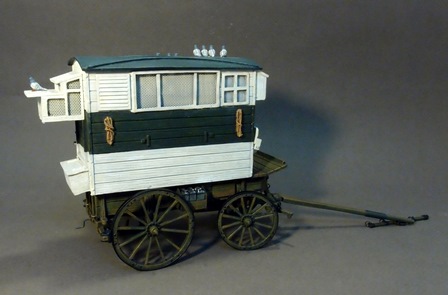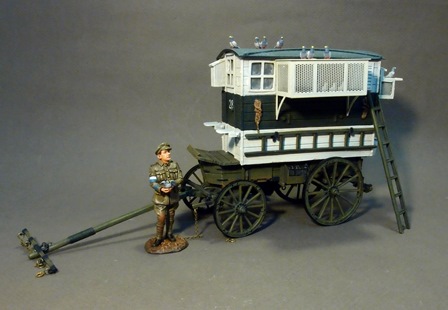
THE GREAT WAR 1914-1918
GWB-15
Mobile Pigeon Loft
(2 pcs)
US$178
Pigeons played an exceptional role in WWI and WWII.
Pigeons were able to fly over enemy lines to send messages to allies all over
the continent without the risk of having planes shot down or vehicles destroyed trying to relay that same message.
Although many pigeons were killed in the process of transferring these messages,
their success was great enough to merit the establishment of the Pigeon Corps in 1915.
This group started with 15 mobile pigeon stations,
or pigeon wagons, each with 4 birds and a handler and grew in size to over 400 men and 22,000 pigeons by the end of the war.
Pigeons had a small canister attached to their legs that allowed
for a message to be inserted and transported back to command posts.
This system proved to be the most effective means of transporting important messages as pigeons are incredibly fast fliers
and the telegraph system that existed during the war was still not very efficient.
Many of these pigeons carried messages that saved the lives of many soldiers, and as a result,
were awarded medals for heroism and service to their respective countries.
One pigeon named 'Red Cock' carried a message that contained
the coordinates of a sinking boat that had been torpedoed back to its loft at the command post
which allowed a rescue team to be dispatched in time to save the crew.
For his services, 'Red Cock' was awarded the Dickin Medal for his bravery.
This medal is the animal equivalent of the Victoria Cross which is awarded to individuals "for most conspicuous bravery,
or some daring or pre-eminent act of valour or self-sacrifice,
or extreme devotion to duty in the presence of the enemy."

The Dickin Medal is the highest honor
that an animal can be awarded for military service,
and of the 55 Dickin Medals awarded to animals,
32 of them were awarded to pigeons.
Another pigeon named 'Cher Ami' had an even more fascinating story.
In 1918, 500 allied soldiers were trapped with no food
or ammunition in France and were being bombarded by friendly fire.
Many men were being killed and there seemed to be no hope of surviving the attack.
As a last ditch effort a message was attached to a pigeon
which was released and immediately shot down by the enemy.
A second pigeon was released with a message and a suffered a similar fate.
The final pigeon, 'Cher Ami' was then called for. As with the first two birds,
a message was attached to its leg and it was released into the sky. 'Cher Ami'
was instantly shot through the breast and fell to the ground;
however, unlike his predecessors, 'Cher Ami' got back up and continued to fly another 25 miles,
amidst a sky of bullets and the chaos of war,
all the way back to headquarters.
He delivered the message and was able to save the 194 remaining soldiers from certain death;
however, his wounds consisted of a shot through the breast,
a blinded eye and a nearly unattached leg.
Miraculously,
medics were able to save the bird and replaced his wounded leg with a wooden one.
For his services, 'Cher Ami' was awarded the Croix de Guerre Medal,
inducted into the racing pigeon hall of fame,
and became the mascot of the Department of Service.

We now accept PAYPAL,
to purchase your figures please send your order by e-mail to
inquiry@johnjenkinsdesigns.com
after checking that everything is available,
you will be billed via PAYPAL.
your order will be shipped on confirmation of payment.
worldwide airmail 12%
(minimum postage us$10)
JOHN JENKINS DESIGNS
UNIT 6H, TOWER 1,
KING LEY IND. BUILDING,
33-35 YIP KAN STREET,
WONG CHUCK HANG,
HONG KONG,
tel/fax; 852 2553 9313
